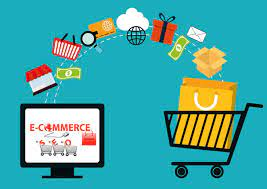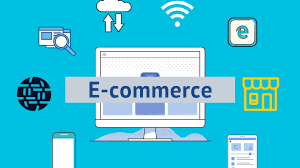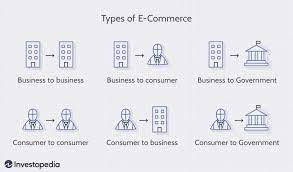
E-commerce, or electronic commerce, refers to online marketplaces for goods and services and the buying and selling goods and services over the Internet. It has revolutionized businesses and opened new opportunities for entrepreneurs and established businesses. In this article, we will explore the different aspects of e-commerce and how it has changed how we do business online.
What is E-commerce?
E-commerce is buying and selling products or services online over the internet. It involves various technologies like mobile devices, e-commerce websites, electronic funds transfers, and online payment systems. E-commerce can occur between businesses, businesses, consumers, or consumers themselves.
Types of E-commerce:
There are several types of e-commerce, including:
- Business-to-Business (B2B) E-commerce: This type of e-commerce involves transactions between two businesses. Businesses use B2B e-commerce to source raw materials, purchase supplies, and make other business-related purchases.
- Business-to-Consumer (B2C) E-commerce: This type of e-commerce involves transactions between businesses and consumers. Companies use B2C e-commerce to sell products and services directly to consumers.
- Consumer-to-Business (C2B) E-commerce: This type of e-commerce involves transactions between consumers and businesses. Consumers use C2B e-commerce to sell products or services to companies.
- Consumer-to-Consumer (C2C) E-commerce: This type of e-commerce involves consumer transactions. Consumers use C2C e-commerce to sell products or services to other consumers.
Advantages of E-commerce:
E-commerce offers a range of advantages and disadvantages for businesses, online retailers, and consumers alike, including:
- Increased Reach: E-commerce allows businesses to reach customers worldwide, breaking geographical barriers.
- Reduced Costs: E-commerce eliminates the need for physical storefronts and reduces other costs associated with traditional retail.
- Improved Customer Experience: E-commerce allows customers to shop online conveniently and provides a more personalized shopping experience.
- Greater Flexibility: E-commerce allows businesses to operate 24/7, giving customers greater flexibility regarding when and how they shop.
- Increased Data Insights: E-commerce provides businesses with valuable data insights into customer behavior, which can be used to improve products and services.
Disadvantages of E-commerce:
While e-commerce offers many advantages to how businesses sell online sales, there are also some potential disadvantages to consider, including:
- Security Concerns: E-commerce transactions can be vulnerable to fraud and cyber-attacks, putting sensitive customer information at risk.
- Lack of Personal Interaction: E-commerce eliminates the personal interaction between businesses and customers, which can be crucial in building customer loyalty.
- Shipping Costs: E-commerce can be expensive for shipping and handling, impacting profit margins.
- Competition: E-commerce has opened up new business opportunities and increased competition, making it harder for companies to stand out.
E-commerce has revolutionized how we do business, offering a range of benefits for businesses and consumers alike. Whether you are an e-commerce company, an e-commerce business in growth, a small business looking to expand your reach, or a consumer looking for more convenient ways to shop, e-commerce has something to offer. With the right strategy and approach, e-commerce can be a powerful tool for success in the modern business world.

Merits and Demerits of E-commerce:
While there are many benefits of e-commerce, there are also potential drawbacks that should be considered. One of the main advantages of e-commerce is its ability to reach customers worldwide, breaking down geographical barriers. This can help businesses expand their customer base and increase revenue. Additionally, e-commerce can reduce costs associated with traditional retail, such as rent and utilities, allowing companies to operate more efficiently.
On the other hand, e-commerce transactions can be vulnerable to fraud and cyber attacks, which can put sensitive customer information at risk. This can damage the online retailer’s reputation as a business and result in lost revenue. Additionally, e-commerce eliminates the personal interaction between companies and customers in physical stores, which can be crucial in building customer loyalty. Shipping and handling costs for online transactions can also be expensive, impacting profit margins.
Types of E-commerce Business Models:
There are several different business models used in e-commerce, including:
- Retail: Retail e-commerce involves businesses selling products directly to consumers through an online storefront.
- Wholesale: Wholesale e-commerce involves businesses selling products in bulk to other companies.
- Dropshipping: Dropshipping e-commerce involves businesses selling products through an online storefront but outsourcing the fulfillment and shipping process to a third-party supplier.
- Subscription: Subscription e-commerce involves businesses offering products or services regularly, such as monthly or quarterly subscriptions.
- Marketplace: Marketplace e-commerce involves businesses offering other businesses or individuals a platform to sell products.
Successful E-commerce Strategies:
To succeed in e-commerce, businesses must develop a robust Internet of commerce business strategy that considers the unique challenges and opportunities of the online marketplace. Some critical plans to consider for e-commerce stores include the following:
- Develop a strong brand: Building a solid brand is essential for establishing trust with customers and differentiating yourself from competitors.
- Optimize for search engines: Optimization (SEO) is critical for ensuring your website appears at the top of search engine results pages (SERPs).
- Offer a personalized experience: Personalizing the customer experience can help build loyalty and increase sales.
- Use social media: Social media can be a powerful tool for promoting your brand and reaching new customers.
- Focus on mobile optimization: With more and more people using portable devices to shop online, ensuring your website is optimized for mobile is essential.
- Prioritize customer service: Excellent customer service can help build loyalty and increase repeat business.
E-commerce has changed how businesses operate, offering new opportunities for entrepreneurs and established companies. However, e-commerce also comes with its unique challenges and considerations. Nevertheless, by developing a solid strategy and delivering a high-quality customer experience for online purchases, companies can succeed in the now online retail marketplace and outrank their competitors.

E-commerce Trends and Future Outlook:
As technology continues to evolve, e-commerce is also changing rapidly.
Here are some of the latest trends and predictions for the future of e-commerce:
- Mobile commerce: As more and more people use mobile devices to shop online, mobile optimization will become increasingly important for e-commerce businesses.
- Artificial intelligence: AI-powered tools can help businesses personalize the customer experience and automate routine tasks like customer service.
- Social commerce: Social media platforms like Instagram and Facebook are increasingly becoming popular for businesses to sell products directly to consumers.
- Voice commerce: As voice-enabled devices like Amazon’s Alexa and Google Home become more ubiquitous, they will play an increasing role in e-commerce.
- Sustainability: Consumers are increasingly interested in purchasing from companies prioritizing sustainability and environmental responsibility.
- Augmented reality: AR technology can allow customers to “try on” products virtually, providing a more immersive shopping experience.
Overall, the future of e-commerce looks bright, with continued growth and innovation expected in the e-commerce company receives the years to come.

The Importance of a Strong E-commerce Strategy:
To succeed in the highly competitive world of e-commerce, it’s essential to have a well-developed strategy in place.
Here are some key elements of a strong e-commerce strategy:
- Clear target audience: Knowing your target audience will help you tailor your marketing efforts and product offerings to their needs and preferences.
- Effective branding: Strong branding can help you stand out in a crowded market and build a loyal customer base.
- User-friendly website: Your website should be easy to navigate and use, with clear calls-to-action and a streamlined checkout process.
- High-quality product offerings: Offering high-quality, in-demand products is essential for building a solid reputation and encouraging repeat business.
- Customer service: Providing excellent customer service is crucial for building trust and establishing a positive reputation.
- Data analytics: Collecting and analyzing data can help you make informed decisions about marketing, product offerings, and customer service.
By prioritizing these elements in your e-commerce strategy, you can position your online shopping experience and business model well for long-term success and growth.

The History of E-commerce
E-commerce has a rich history dating back to the early 1970s when the first electronic commerce sales transactions occurred. Since then, the business sells e-commerce has evolved significantly with the rise of the internet and advancements in technology. Today, e-commerce is a massive industry that accounts for trillions of global retail sales.
Current State of E-commerce E-commerce has seen massive growth in recent years, with more businesses doing retail e-commerce sales and consumers turning to online shopping. In addition, the COVID-19 pandemic has further accelerated the growth of e-commerce, as people have been forced to stay at home and turn to online stores for shopping for their daily needs. This trend is expected to continue even after the pandemic, making e-commerce an essential aspect of modern online business now.
Benefits of E-commerce E-commerce or e-commerce platform offers a range of benefits to both businesses and consumers. For companies using an e-commerce site or media,-commerce provides a global reach, allowing them to sell to customers worldwide. It also provides a cost-effective way to reach new customers and reduce overhead costs. For consumers, e-commerce offers convenience, a wide range of products, and competitive pricing.
Challenges of E-commerce While e-commerce offers numerous benefits, it also presents several challenges. One of the biggest challenges traditional e-commerce has is the high level of competition in the industry, making it challenging for small businesses to stand out. Another challenge is the need to keep up with constantly evolving technology and consumer behavior, which can be costly and time-consuming.
Future of E-commerce, The end of e-commerce looks bright, with continued growth and innovation expected in the e-commerce sales industry. Some trends expected to shape the future of e-commerce include the increased use of AI and machine learning, the rise of mobile e-commerce sites, and the continued growth of global e-commerce.
Conclusion E-commerce is a rapidly growing industry that offers numerous opportunities for businesses and consumers. To succeed in this industry, it is essential to understand its history, current state, and future predictions. Then, with the right strategy for digital products and an approach to limited customer service, businesses can take advantage of the benefits of e-commerce and stay ahead of the competition.

One of the eCommerce platform’s key benefits is allowing businesses to reach a wider audience. Companies can sell their products and services to customers worldwide with an online store. The eCommerce platform also provides customers the convenience of shopping online from the comfort of their homes at any time of the day or night.
Types of eCommerce There are several types of eCommerce transactions, including B2B (business-to-business), B2C (business-to-consumer), C2C (consumer-to-consumer), and C2B (consumer-to-business). For example, B2B eCommerce refers to business transactions, while B2C or eCommerce business involves selling products and services directly to consumers. Likewise, C2C eCommerce relates to consumer transactions, while C2B or eCommerce business involves consumers selling products or services to businesses.
Key Elements of a Successful eCommerce Website
To create an entire business to administration successfully an eCommerce and selling online store and website, companies need to ensure that they have the following critical elements in place:
User-friendly design: A website that is easy to navigate and use is crucial for a positive user experience.
High-quality product images: Customers want to see what they are buying, so they are essential.
Clear product descriptions: Product descriptions should be clear and informative, providing customers with all the information they need to purchase.
Secure payment gateway: A secure payment gateway is crucial to protect customer information.
Customer reviews: Including customer reviews on a website can help build trust with potential customers and encourage them to purchase.

Businesses can benefit greatly from having an online store
To continue our discussion on eCommerce, it is essential to note that businesses can benefit significantly from having a physical storefront and an online store. In addition to providing customers convenience and accessibility, your eCommerce store can help companies to reduce overhead costs associated with maintaining a physical store storefront.
One of the challenges that businesses may face when creating an eCommerce website is ensuring that it is optimized for search engines. This is where search engine optimization (SEO) comes into play. By optimizing their website for search engines, businesses can increase their visibility online and attract more potential customers.
To optimize an eCommerce website for SEO, businesses should create high-quality, keyword-rich content. This includes product descriptions, blog posts, and other types of content that can help improve their search engine rankings. In addition, eCommerce businesses should also focus on building high-quality backlinks, improving website speed and mobile responsiveness, and incorporating social media into their online marketing advertising strategies.
CoopBusiness is a revolutionary cooperative business-building platform that empowers individuals to become entrepreneurs, business owners, and financially independent.
As a member, you’ll receive top-level business mentorship, access to our proprietary business systems, and the opportunity to access the funds you want to turn your business ideas into reality.